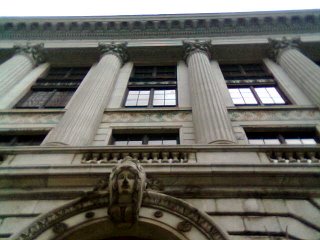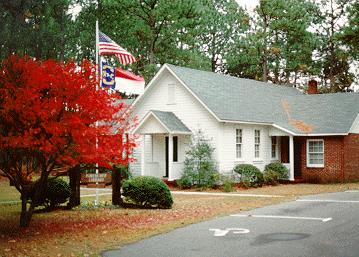structure & infrastructure
Our text is, of necessity, an effort to cover a broad topic in a limited space. As such, the author has chosen to discuss the administration of public libraries prior to discussing the facilities that public libraries are located in. But the relative importance one places on the two topics - administration and architecture - comes back to how one views the linkage between the two topics. Are library buildings built to support the way library staffs need to and want to operate? Or, are they built in response to other community interests and the library staffs then must find ways to carry out their work within the bounds of a building not necessarily built for them? And do library staffs have a structural model that governs how they work, or are they, of necessity hammered into a mold forced on them by fiscal realities?
structure
 This
week, take the opportunity to follow your interests. If your
interest is in what the text's author calls "the symbolism of the
public library building," then read and consider the library
structure itself topics. Read about how the American public library
has gone through different phases of thinking about what a library
should look like. Older models were fairly classical and rigid in
look, but that look and sense of solidity had merit in its own
right.
This
week, take the opportunity to follow your interests. If your
interest is in what the text's author calls "the symbolism of the
public library building," then read and consider the library
structure itself topics. Read about how the American public library
has gone through different phases of thinking about what a library
should look like. Older models were fairly classical and rigid in
look, but that look and sense of solidity had merit in its own
right.
The image to the right is what one sees if one looks up from the front door of the main library in downtown Cleveland, Ohio. It is an imposing edifice and when one enters the building, it has a bit of the feel of a cathedral of learning. Not everyone likes that feel, however, and there are many who feel that it is too intimidating.
 The
next image to the right is public library in Pinebluff, North
Carolina. Unlike the library in Cleveland, this building was not
originally custom-built to be the library. It was originally a
one-room schoolhouse and later became town hall. In 1956, the town
took out a construction bond to pay for the building of a wing onto
town hall for the library to occupy. In 1994, the town built a new
town hall and gave the old building to the library so it could
expand its space. It's a small place, but it fits the needs of most
of the residents of the small town in which it is located. It is not
at all an imposing edifice and, instead of feeling like a cathedral
of learning, it feels like what one might imagine one's
grandmother's house would feel like, if grandmother had had a room
with lots of bookshelves.
The
next image to the right is public library in Pinebluff, North
Carolina. Unlike the library in Cleveland, this building was not
originally custom-built to be the library. It was originally a
one-room schoolhouse and later became town hall. In 1956, the town
took out a construction bond to pay for the building of a wing onto
town hall for the library to occupy. In 1994, the town built a new
town hall and gave the old building to the library so it could
expand its space. It's a small place, but it fits the needs of most
of the residents of the small town in which it is located. It is not
at all an imposing edifice and, instead of feeling like a cathedral
of learning, it feels like what one might imagine one's
grandmother's house would feel like, if grandmother had had a room
with lots of bookshelves.
The new Seattle public library building is a source of interest for lots of people, for lots of reasons. There were many reasons why the people who funded this building wanted it built in this fashion, but it hasn't been a complete hit with everyone, in part because of its shape, in part because of how different it is from the classical ideal, from the model that the Cleveland Public Library exemplifies.
If this is your interest, compare the readings with the library you know best. How well does the library you know work for the community, for the patrons, and - not least - how does it work for the staff?
infrastructure
Or, if the form of the building doesn't much matter to you, but the way in which it works does, then perhaps you might want to focus on the chapter in the text that talks about organizational models. If that is your choice, compare the models she discusses with the reality of your own situations. How well does your organizational structure work for your library, or for the way you think your library ought to work? You might find it enlightening to use the links provided on the readings page to compare your library with others - either with others in North Carolina (if you are a North Carolinian) or with others in other states. Feel free to offer opinions on how management should be structured - does your library need a flatter organizational structure (do the various compartments get in the way of customer service?) or does it need a more robust support structure in order to more fully support the patrons (more tech support, better technical services, more security, perhaps a collaborative arrangement with other local or regional libraries)?
Both these topic areas are related, and this week I hope you take the opportunity to spread your wings and think about how you would build the library building and/or how you would staff it.
... if you were the ruler of all you survey ....
[top]